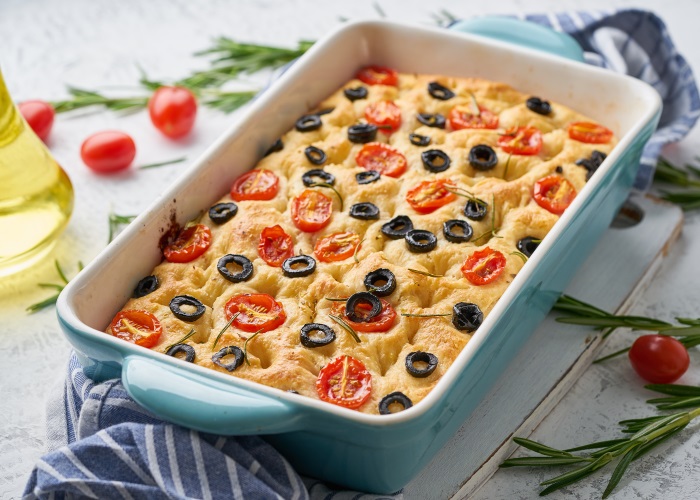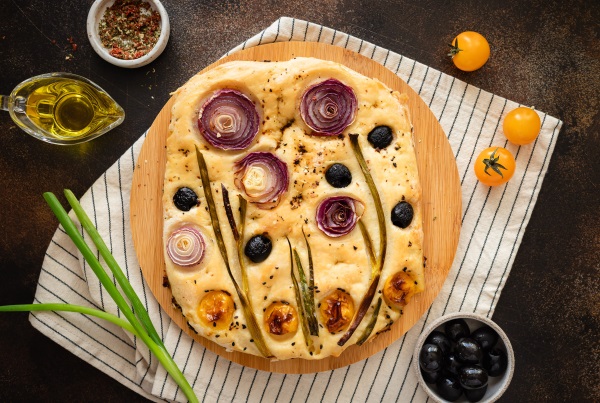Focaccia… Just the name alone brings to mind the sun-drenched streets of Genoa, the aroma of warm olive oil, and the golden, slightly crispy top of a freshly baked bread. Often referred to as the Italian cousin of pizza, focaccia is much more than just flatbread. It’s a symbol of simplicity, generosity, and Mediterranean flavor.
In this post, you’ll learn how to make authentic Italian focaccia from scratch, with detailed steps, pro tips, and a few delicious variations.
What Is Focaccia Bread?
Focaccia is a traditional Italian flatbread, usually topped with olive oil and sea salt. In Liguria (where Genoa is located), it’s eaten all day long: at breakfast dipped in coffee, as a snack, or as a side for lunch and dinner.
The texture? Tender and open on the inside, with a crunchy, bronzed top layer and those trademark indentations that hold onto the olive oil and all the delicious flavors. It’s very similar to a German Flammekueche Pie, minus the generous amounts of olive oil and few other ingredients.
If you’re wondering why I’m sharing this focaccia recipe today, it’s because of a trip I took to Italy not too long ago.
Stumbling into Focaccia Heaven in Altamura
I hadn’t even heard of Altamura before this vacation. My plan was simple: spend the day exploring Matera’s famous cave houses and call it a win. But during breakfast at my hostel, a guy from Bari overheard me talking about bread and said I should skip the tourist stuff and go to Altamura if I want real focaccia.
An hour later, I was on a rattly bus headed there with zero expectations. The town was small and sleepy, but the smell of baking bread hit me the second I got off. I wandered through narrow stone streets, past old men playing cards and little shops selling olive oil and flour.
Eventually, I found this tiny bakery Antico Forno Santa Chiara. No sign, no frills, just locals lining up for warm squares of focaccia. I grabbed one, still hot and glistening with olive oil, and sat on a bench outside.
First bite? Unreal. Crispy edges, soft middle, tomatoes just starting to caramelize, and enough olive oil to soak my fingers. Way better than anything I’ve had back home.
I did make it to Matera later, and yeah, the caves were cool. But honestly? That unexpected focaccia stop in Altamura was the highlight of my day.
So, if you want to enjoy the same goodness you don’t really have to go to Italy, you can make it like I did in the coziness of your home kitchen. Here we go…
Essential Ingredients for Authentic Focaccia
To make a proper Italian focaccia at home, you’ll need:
- 500 g (about 4 cups) of 00 flour (or a mix of 00 and Manitoba flour for extra gluten strength)
- 320 ml (about 1 1/3 cups) of warm water
- 7–10 g (about 2 tsp) of active dry yeast (or 20 g fresh yeast)
- 30–50 ml (2–3 tbsp) of extra virgin olive oil (plus more for topping)
- 2 tsp of fine sea salt
- 1 tsp of sugar (optional, helps activate the yeast)
- Toppings: Flaky sea salt, fresh rosemary, olives, cherry tomatoes, or onions (optional)
Step-by-Step Recipe
1. Activate the Yeast
In a small bowl, mix the active dry yeast with the warm water and sugar. Let it sit for about 10 minutes until it starts to foam slightly. This tells you the yeast is alive and ready.
2. Make the Dough
In a large mixing bowl, combine the flour and salt. Make a well in the center and slowly pour in the water-yeast mixture and olive oil. Mix with egg beater whisk, knead with your hands or with a dough hook on a stand mixer for about 10 minutes, until you get a smooth, elastic, and slightly sticky dough.
Pro Tip: Don’t be afraid if the dough feels a little wet. High hydration is key for that fluffy, airy texture.
3. First Rise
Cover the bowl with a damp cloth or plastic wrap. Let the dough rise at room temperature for 1.5 to 2 hours, or until it has doubled in size.
4. Second Rise
Cover the dough loosely and let it rise again for 30 to 40 minutes until puffed.
5. Shaping the Dough
Generously oil a baking tray or rectangular pan. Transfer the dough to the pan carefully don’t punch it down too much. With well-oiled hands, gently stretch the dough to fill the pan.
6. Create the Famous Dimples (optional)
With your oiled fingertips, press into the dough to create the signature dimples all over the surface. Drizzle with more olive oil and sprinkle generously with flaky sea salt and fresh rosemary.
7. Baking
Preheat your oven to 230°C (445°F), fan setting if possible.
Bake for 20 to 25 minutes, until the focaccia is golden brown on top. The bottom should be firm but not overly hard.
Baking Tip: For extra crispiness, place a small oven-safe dish with water at the bottom of the oven to create steam.
8. Finishing Touch
Right out of the oven, drizzle a little more olive oil on top for extra flavor and shine.
Let the focaccia cool slightly before cutting into generous squares.
My Tips for Perfect Focaccia
- Flour choice matters: Traditional Italian recipes prefer “00” flour for its fine texture, but high-quality bread flour works well too.
- Hydration: A wetter dough creates a softer crumb. Adjust water slightly based on humidity and flour brand.
- Olive oil quality: Use extra virgin olive oil for flavor and moisture and this is crucial!
- Resting between stretches: Letting the dough rest during shaping makes it easier to stretch without tearing.
- Toppings variations: Besides rosemary, try sliced olives, cherry tomatoes, garlic, or caramelized onions for regional twists.
- Overnight fermentation: For deeper flavor, refrigerate the dough overnight after the first rise and bake the next day.
Three Artisan Ways to Shape and Decorate Your Focaccia Bread
Once you’ve mastered the basic dough, the fun part begins: shaping and decorating. Staying true to Italian simplicity, here are three beautiful ways to prepare your focaccia using just rosemary, olive oil, and sea salt, no tomatoes, no cheese, just pure rustic artistry.
Classic Bakery Style (Rectangular Pan)
This is the traditional look you’ll find in most Italian bakeries. The dough is stretched to fill a rectangular tray, then generously dimpled with your fingertips, drizzled with olive oil, and sprinkled with sea salt and rosemary. The result? Deep golden edges, a light airy center, and that unmistakable bakery smell filling your kitchen.
No Tomato Version: Olive Oil and Herb Simplicity
For those who prefer focaccia without tomatoes, keep it beautifully simple by focusing on the essentials: generous olive oil, fresh rosemary, and flaky sea salt. This version emphasizes the pure, rustic flavor of the bread itself, allowing the fragrant herb and silky oil to shine without any distractions.
Round Focaccia with Decorative Artsy Herb Patterns
For a more artisan touch, shape your dough into a round form and get creative with your toppings. Use rosemary sprigs to create leaf or flower designs across the surface before baking. Think of it as focaccia meets edible art, but still 100% traditional in flavor and ingredients.
Pro Tip: Lightly press the herbs into the dough so they stay in place during baking.
Mini Individual Focaccia (Rustic Dinner Roll Style)
Divide the dough into smaller portions and shape them into free-form rounds, like rustic rolls. Perfect for serving alongside soups or as personal-sized portions for guests. Give each one its own olive oil drizzle, dimples, and a small rosemary sprig on top. These mini focaccias bake a little faster (about 15–18 minutes) but still deliver that same golden crust and soft, airy interior.
Regional Focaccia Variations
Focaccia Barese (from Puglia): Topped with cherry tomatoes, oregano, and black olives.
Focaccia di Recco: Ultra-thin and stuffed with creamy Stracchino cheese.
Focaccia con Cipolle (Genoese-style with onions): Covered with slow-cooked sweet onions.
Each region of Italy has its own version, and experimenting with toppings is part of the fun.
How to Serve Focaccia
Focaccia is a total all-rounder and perfect for any meal or occasion:
- As an appetizer, cut into small squares.
- As sandwich bread, sliced and filled with grilled vegetables or Italian cured meats.
- As a side dish with soups and salads.
- Simply warm with a glass of crisp white wine.
How to Store Focaccia Bread
To enjoy focaccia at its best even a day or two later, store it properly and here’s what I usually do to keep it fresh:
- Room temperature: Wrap the focaccia tightly in plastic wrap or place it in an airtight container. It stays fresh for up to 2 days. Before eating, warm it briefly in the oven for that fresh-baked feel.
- Refrigeration: Refrigerating focaccia can dry it out, so only do this if you plan to keep it longer than 2 days. Wrap tightly and reheat well before serving.
- Freezing: For longer storage, wrap focaccia tightly in plastic wrap and then aluminum foil or place in a freezer bag. Freeze for up to 3 months. Thaw overnight in the fridge and refresh in a hot oven for 5–10 minutes.
Authentic Focaccia bread Recipe
Share on Facebook Share by EmailIngredients
- 500 g about 4 cups 00 flour (or mix with Manitoba flour)
- 320 ml 1 1/3 cups warm water
- 7 –10 g 2 tsp active dry yeast (or 20 g fresh yeast)
- 30 –50 ml 2–3 tbsp extra virgin olive oil (plus more for topping)
- 2 tsp fine sea salt
- 1 tsp sugar optional, helps yeast rise
- Toppings: Flaky salt rosemary, olives, tomatoes, or onions (optional)
Instructions
- Activate Yeast:
- Mix yeast, warm water, and sugar. Let sit 10 minutes until foamy.
- Make Dough:
- In a bowl, combine flour and salt. Add yeast mix and olive oil. Knead 10 minutes by hand or mixer until smooth and slightly sticky.
- First Rise:
- Cover and let rise 1.5 to 2 hours at room temp until doubled.
- Shape Dough:
- Oil a baking pan well. Gently stretch dough to fill the pan.
- Second Rise:
- Cover and let rise 30–40 minutes until puffy.
- Dimple and Top:
- Press oiled fingers into dough to make dimples. Drizzle olive oil and add toppings like rosemary and sea salt.
- Bake:
- Bake at 230°C (445°F) for 20–25 minutes until golden.
- Finish:
- Drizzle with more olive oil. Cool slightly, then slice and enjoy.
Notes
Final Thoughts
Making authentic Italian focaccia at home is easier than you think, as long as you give the dough time to rise and don’t skimp on quality olive oil. The result is a soft, fragrant bread with just the right amount of crunch and flavor.
So, the next time you’re craving a taste of Italy, skip the store-bought versions and make your own. Your kitchen will smell amazing, and your guests (or just you) will thank you.
Buon appetito!













